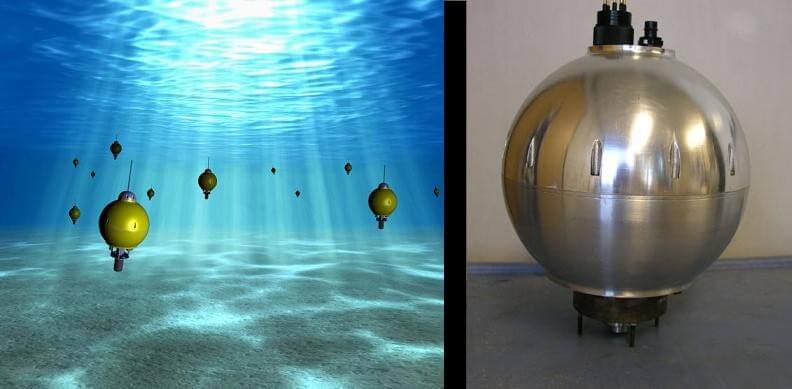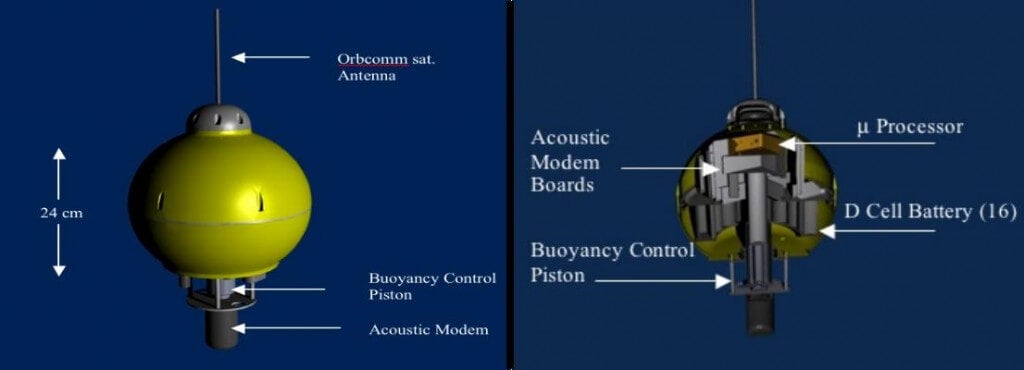Swarm of Underwater Drones To Help Explore Ocean

Share
Release the drones! Jules Jaffe from UC San Diego's Scripps Institute just received $1 million in funding from the National Science Foundation to build a fleet of drones to explore the ocean. The Autonomous Underwater Explorers (AUE) could help track everything from tsunamis to squid spawn. Looking like miniature Death Stars, the soccer ball sized AUEs will be able to control their buoyancy as they are carried by currents to help researchers map the ocean's behavior at different levels. Once deployed, the AUE program could help determine the efficacy of protected marine habitats, retrieve the black box from a crashed plane, or track an oil spill.

The underwater drone swarm will eventually help researchers at UC San Diego explore the ocean (left). Right now, there are only five or six of the prototypes (right).
While the AUEs aren't exactly articulated machines, they have many of the features and benefits of swarm robotics. As with many swarm robots, their strength is in numbers, and communication between individual bots. A solitary drone could only tell researchers about the conditions in its immediate vicinity. A fleet of drones will be able to describe their relative movement and the variations in ocean activity. It's a cool concept that has great scalability. Right now Jaffe is planning on hundreds of drones, but imagine what we could learn with thousands or millions. The ocean is the last great frontier on Earth and these unmanned devices may be our best way of exploring it.
Jaffe is already building several prototypes for the AUE, including five or six of the soccer-ball sized 'motherships' and about 20 of a smaller version (the mini-AUE). The smaller and larger drones will be able to communicate via acoustic signals. A single mothership AUE could be moored while talking to free floating AUEs and mini-AUEs. The larger drones may have GPS trackers, while the smaller would not. This sort of network would allow Jaffe to measure ocean drift.
Other researchers have built buoyant drones before, some even more sophisticated. Yet none have taken measurements over the distance or period of time that Jaffe's will. By dispersing a swarm of AUEs and mini-AUEs, Jaffe's team could get a unique spatial and temporal understanding of the ocean.

Here's a better look at what's going on inside the AUE.
The following video is a presentation Jaffe gave explaining his AUE project. It's a bit long and may not appeal to those unaccustomed to listening to scientific lectures. You can skip to 26:30 to hear Jaffe introduce the AUE device. He describes the mini-AUE (and shows a prototype) around 31:15. If you stick around to 38:25 and 47:30 he'll tell you about the use of AUEs to locate plane crashes, and how building a mini-AUE might become a great project for middle school and high school students.
Be Part of the Future
Sign up to receive top stories about groundbreaking technologies and visionary thinkers from SingularityHub.


As Jaffe briefly described in the video, the AUEs could be modified with different kinds of instrumentation. They may measure salinity, dissolved oxygen, pH, chlorophyll levels, or turbidity of water. Each of these variables has a significant effect on ocean life. Taken collectively they could give a detailed account of marine habitats, helping governments decide if protected areas of the ocean are thriving.
But there's really no limit to what these drones could learn. Biological info on marine habitats, meteorological on currents, seismological measurements on underwater earthquakes...the list goes on. Which is probably why the NSF has given Jaffe and his colleagues another $1.5 million to help with the control mechanisms for the movement of the AUEs. Each little drone is just a ball bobbing along under the water's surface. As a collective they could be a vast net to catch all the secrets of the ocean. Maybe they'll finally be able to tell me where the monster from Cloverfield came from.
[photo credit: Jaffe Lab, UCSD]
Related Articles

These Robots Are the Size of Single Cells and Cost Just a Penny Apiece

In Wild Experiment, Surgeon Uses Robot to Remove Blood Clot in Brain 4,000 Miles Away

A Squishy New Robotic ‘Eye’ Automatically Focuses Like Our Own
What we’re reading